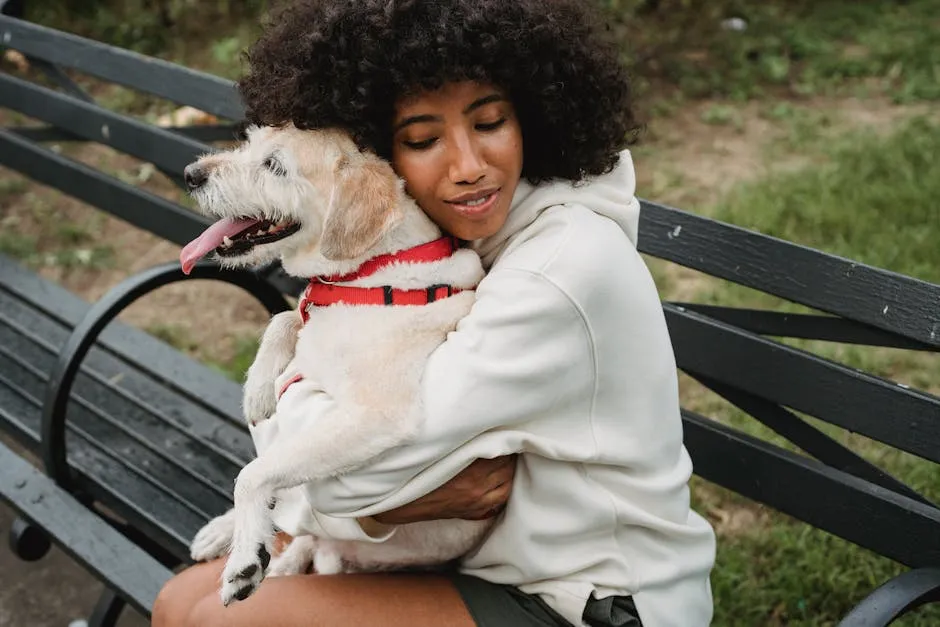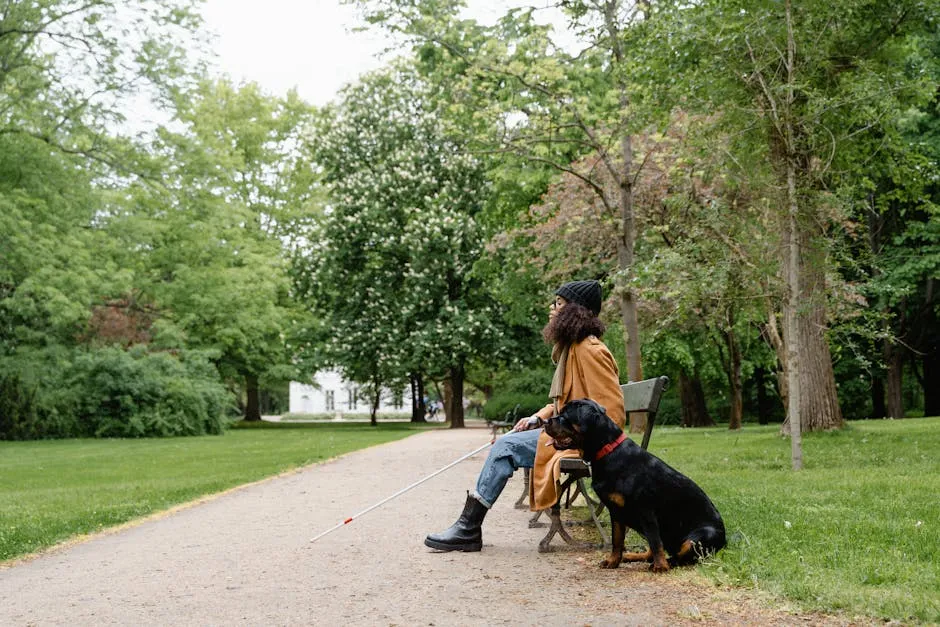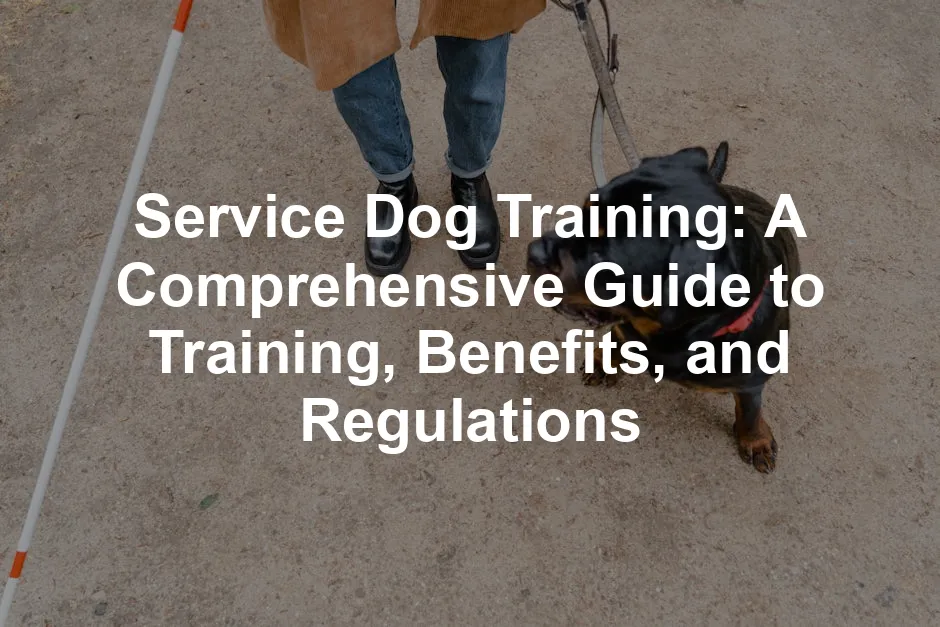Introduction
Service dogs are not merely pets; they are invaluable companions for individuals with disabilities. These remarkable animals provide assistance, emotional support, and a sense of freedom. Imagine navigating life with a furry friend who knows how to alert you to an oncoming seizure or guide you safely through crowded spaces. It’s not just a dream; it’s a reality for many thanks to service dogs. Training a service dog involves teaching them specific tasks that directly assist their handlers. This training can significantly improve the quality of life for those with disabilities, allowing them to engage more fully in their communities. As awareness of service dogs grows, so does the interest in understanding the training process. In this guide, we will cover the essential skills needed for service dogs, various training methods, and the benefits they bring to their handlers. We’ll also explore the legalities surrounding service dogs, clarifying what constitutes legitimate service dog training as opposed to other forms of assistance animals. Whether you’re considering training a service dog yourself or simply want to learn more about the process, this guide is designed for you. So, let’s embark on this journey together and uncover how these incredible animals can change lives!
Summary
Service dogs are crucial allies for individuals with disabilities, trained to perform tasks that enhance their handlers’ independence. From guiding the visually impaired to aiding those with medical conditions like epilepsy, the roles of service dogs are diverse and essential. This article explores the various types of service dogs, the benefits they offer, and the comprehensive training processes involved. We will clarify the differences between service dogs, emotional support animals, and therapy dogs, along with the legal definitions and regulations that govern service animals. You’ll learn about the critical steps in training your own service dog, including evaluating your dog’s temperament, socialization techniques, and task-specific training. We will also discuss common challenges, such as the growing issue of fake service dogs and how to ensure that your service dog meets legal standards. By the end of this article, you’ll gain a deeper understanding of service dog training, the vital role these dogs play in society, and the resources available for those interested in training or acquiring a service dog. So, let’s take a closer look into the fascinating world of service dog training and its potential to transform lives!
Benefits of Service Dogs
Understanding the Scope of Service Dogs
Service dogs are remarkable companions trained to assist individuals with disabilities. According to the Americans with Disabilities Act (ADA), a service dog is defined as a dog that is specifically trained to perform tasks for a person with a disability. This includes both physical and mental impairments that significantly limit one or more major life activities. These amazing animals can take on various roles. For instance, guide dogs help visually impaired individuals navigate their surroundings. Mobility assistance dogs assist those who have difficulty walking. Medical alert dogs notify their handlers of impending medical issues, like seizures or low blood sugar. Psychiatric service dogs provide support for people dealing with conditions such as PTSD or severe anxiety. In recent years, the scope of service dogs has expanded greatly. As awareness grows, so does the understanding of how these dogs can be trained to help people lead more fulfilling lives. It’s not just about companionship; it’s about independence and empowerment.
Health and Emotional Benefits
The benefits of service dogs extend beyond their physical assistance. They significantly enhance the quality of life for their handlers. One of the most important advantages is the increased independence they provide. Handlers can navigate public spaces, manage daily tasks, and feel more secure in their environments thanks to their service dogs. Moreover, the emotional support these dogs offer is invaluable. Many individuals experience reduced feelings of isolation and loneliness when paired with a service dog. The bond formed between a handler and their dog can lead to improved mental health and overall well-being.
Real-World Examples
Consider the story of Sarah, a young woman living with severe anxiety. After receiving her psychiatric service dog, Max, Sarah reported a drastic decrease in panic attacks. Max was trained to recognize signs of distress and comfort her during those moments. Their journey together showcases the transformative power of service dogs. Another example is John, a veteran with PTSD. His service dog, Bella, helps him navigate social situations. With Bella by his side, John feels more at ease and confident when engaging with others. These stories highlight how service dogs can profoundly change lives, providing both physical assistance and emotional security. In summary, service dogs play a crucial role in enhancing the lives of individuals with disabilities. They provide a unique combination of physical assistance and emotional support, making them indispensable companions. Understanding their diverse roles and the benefits they offer is essential for appreciating the significance of service dogs in society.
Service dogs can greatly enhance the quality of life for their handlers, especially those with cognitive issues. guide to enhancing quality of life for senior dogs with cognitive issues
Types of Service Dogs
Overview of Different Types
Service dogs come in different types, each specially trained for their unique roles.- Guide Dogs: These fur-tastic helpers assist the visually impaired, allowing their handlers to navigate the world safely. They are trained to avoid obstacles and ensure their handler’s safety.
- Mobility Assistance Dogs: These dogs are essential for those with physical disabilities. They help with tasks like retrieving objects, opening doors, and providing balance support.
Medical Alert Dogs
Seizure Response Dogs
Seizure response dogs are like furry superheroes. They can sense an oncoming seizure before it strikes. How do they do this? It’s often a combination of heightened senses and training. These dogs are conditioned to pick up on subtle changes in their handler’s behavior, such as restlessness or unusual movements. Once a seizure is detected, these remarkable pups spring into action. They may alert others nearby, allowing someone to provide help. Some dogs even stay close during a seizure, providing comfort and companionship. After the episode, they assist their handler in regaining composure, ensuring a smooth transition back to normalcy.Diabetic Alert Dogs
Have you ever wished for a canine alarm system for diabetes? Meet the diabetic alert dog! These dogs are specially trained to detect fluctuations in their owner’s blood sugar levels. They can smell chemical changes in their handler’s breath or sweat, alerting them when levels drop too low or soar too high. When a dog senses a dangerous change, they might nudge, paw, or bark to get their handler’s attention. This early warning can be life-saving. They play a critical role in managing diabetes, providing peace of mind and independence to their handlers. To further assist with your dog’s training, using a Dog Training Clicker can make a world of difference. This simple tool allows you to provide immediate feedback, helping your dog learn commands faster and more effectively.Psychiatric Service Dogs
Supporting Mental Health
Psychiatric service dogs are emotional support wrapped in fur. They specialize in assisting individuals with mental health challenges like PTSD and anxiety disorders. These dogs are trained to perform tasks that help their handlers cope with symptoms. For instance, they may interrupt repetitive behaviors, remind their handler to take medication, or provide deep pressure therapy during panic attacks. Their presence alone can create a sense of calm, making social situations feel less daunting. The bond between a handler and their psychiatric service dog is powerful, providing emotional stability and support when it’s needed most.
Task Training
Task training is the heart of service dog training. This involves teaching the dog specific tasks that directly aid the handler’s disability. The tasks can vary widely depending on the individual’s needs. For instance, a dog aiding a visually impaired person might be trained to guide them safely through crowded areas. A diabetic alert dog can be taught to sense when blood sugar levels are too high or low. Similarly, a psychiatric service dog may learn to interrupt self-harm behaviors or provide comfort during anxiety attacks. The key to effective task training is consistency and positive reinforcement. Using treats and praise, handlers can encourage their dogs to perform these essential tasks. It’s crucial for handlers to identify which tasks will be most beneficial for their daily lives. After all, a service dog isn’t just a companion; they’re a vital partner in navigating the world. To reward your dog during training, consider using Dog Treats Training Rewards. These tasty morsels are perfect for encouraging your dog to learn and perform their tasks effectively.Public Access Training
Public access training is equally important. This phase prepares service dogs to behave appropriately in various public settings. It’s about teaching them to remain calm and focused amidst distractions. Imagine taking your service dog into a bustling grocery store. They need to ignore the enticing smells of fresh-baked bread and the excitement of other shoppers. Public access training focuses on this type of self-control. Handlers should expose their dogs to different environments, from parks to busy streets, ensuring they can navigate safely. Training includes commands such as “leave it” and “stay,” which help maintain composure. The ultimate goal is to ensure that the service dog can accompany their handler anywhere with confidence and poise.
Resources for Training
Finding the right resources for training your service dog can make a world of difference. Online Courses: Consider enrolling in reputable online training programs. Schools like the Certified Online Service Dog Training School offer structured courses with professional support. They cover everything from basic commands to task training, ensuring you and your dog are well-prepared. Professional Trainers: If you feel overwhelmed, seeking professional help is a smart move. A qualified dog trainer can guide you through the nuances of training, particularly in task and public access training. This support can save time and enhance the bond between you and your service dog, making your journey smoother and more effective. Additionally, having a Pet First Aid Kit on hand is crucial for any dog owner. Accidents happen, and being prepared can make all the difference in ensuring your furry friend stays safe and healthy.
Please let us know what you think about our content by leaving a comment down below!
Thank you for reading till here 🙂
All images from Pexels





